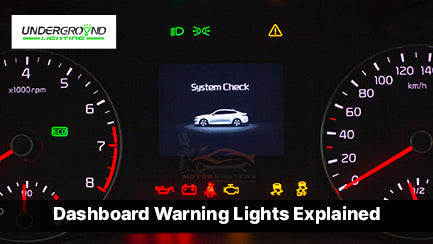Welcome to our comprehensive guide on dashboard warning lights! As a trusted source for automotive information, we aim to provide you with a detailed understanding of the various warning lights that may illuminate your car's dashboard. Our guide will empower you to decode these signals, enabling you to take appropriate action when necessary. Whether you're a seasoned driver or a new car owner, this article will equip you with the knowledge needed to navigate through any warning light situation.
Understanding Dashboard Warning Lights
Modern vehicles are equipped with advanced diagnostic systems that monitor various aspects of your car's performance. When a potential issue is detected, it triggers a dashboard warning light to alert you. These warning lights are designed to be informative and prompt you to take action to prevent further damage or potential safety hazards.
In this section, we will explore some of the most common dashboard warning lights and their meanings. Remember that the specific warning lights and their symbols may vary slightly across different car makes and models. Always refer to your vehicle's owner's manual for accurate information about your vehicle.
Common Dashboard Warning Lights
Check Engine Light
The check engine light, often depicted as an engine-shaped icon, is one of the most frequently encountered warning lights. It typically indicates a potential issue with your car's engine or its related components. When this light illuminates, it is essential to have your vehicle diagnosed by a qualified mechanic to identify and address the underlying problem.

Battery/Charging System Warning Light

The battery or charging system warning light, resembling a battery-shaped icon, signifies an issue with your vehicle's electrical charging system. It could indicate a faulty battery, a malfunctioning alternator, or problems with the charging system. If this light turns on while you're driving, it is advisable to safely pull over and seek professional assistance to prevent a potential breakdown.
Oil Pressure Warning Light

The oil pressure warning light, depicted as an oil can or oil pressure gauge, alerts you to low engine oil pressure. Insufficient oil pressure can result in serious engine damage if left unattended. When this light illuminates, stop your vehicle as soon as it is safe to do so and check your engine oil level. If it's low, add oil immediately. If the light persists, consult a qualified technician to diagnose and rectify the issue.
Tire Pressure Monitoring System (TPMS) Warning Light

The TPMS warning light, represented by an exclamation mark inside a tire shape, indicates low tire pressure in one or more of your vehicle's tires. Properly inflated tires are essential for optimal vehicle performance and safety. If this light is activated, check your tire pressures and inflate them to the recommended levels. If the light persists, there may be a puncture or a malfunction in the TPMS system, requiring professional attention.
ABS Warning Light

The ABS warning light, often displaying the letters "ABS," relates to the anti-lock braking system. If this light turns on, it signifies a potential issue with your vehicle's braking system. While the conventional braking system may still function, the ABS system might be impaired. It is advisable to have your vehicle inspected by a qualified mechanic to diagnose and rectify the issue.
Brake System Warning Light

The brake system warning light, represented by the letters "ABS" inside a circle, typically indicates an issue with the braking system. It could signify low brake fluid levels, worn brake pads, a malfunctioning ABS system, or other brake-related concerns. If this light illuminates, exercise caution while driving and have your vehicle inspected by a qualified technician as soon as possible.
Airbag Warning Light

The airbag warning light, often displaying an image of a person with an inflated airbag, suggests a potential problem with the vehicle's airbag system. When this light turns on, it indicates that the airbags may not deploy in the event of an accident. Promptly seek professional assistance to diagnose and repair the airbag system to ensure your safety and protection.
Coolant Temperature Warning Light

The coolant temperature warning light, resembling a thermometer submerged in liquid, indicates that the engine's coolant temperature is higher than normal. It could be a sign of an overheating engine due to issues like a malfunctioning cooling system, low coolant levels, or a faulty thermostat. If this light illuminates, pull over safely, turn off the engine, and allow it to cool down. Check the coolant levels and inspect for any visible leaks before seeking professional assistance.
ESP/Traction Control Warning Light

The ESP (Electronic Stability Program) or Traction Control warning light, often depicted as a car skidding or with squiggly lines, alerts you to potential issues with the vehicle's traction control or stability systems. If this light remains illuminated, it signifies that these systems may not be functioning correctly, compromising the vehicle's stability and handling. It is advisable to have your vehicle inspected by a qualified technician to diagnose and address the problem.
Washer Fluid Warning Light

The washer fluid warning light, resembling a windshield with wavy lines, indicates low washer fluid levels. While it may not pose a significant safety concern, it's important to maintain proper visibility by keeping an adequate supply of washer fluid. Refill the washer fluid reservoir promptly to ensure clear and unobstructed views while driving.
By familiarizing yourself with these dashboard warning lights and their meanings, you can better understand your vehicle's condition and take appropriate action when necessary. Remember, if any warning light persists or if you are uncertain about its significance, it is always recommended to consult a qualified automotive professional for accurate diagnosis and resolution.
Stay informed, stay safe, and enjoy the peace of mind that comes with a well-maintained vehicle!

